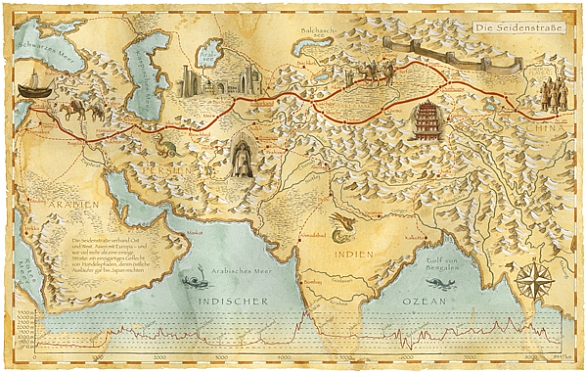
"The Art of Ebru Paper Marbling"
TRAVELERS & THE TRANSMISSION OF KNOWLEDGE
Timeline & Geography
Back >HomePage
CHRONOLOGY OF EVENTS
Click
here

In 1877 the term "Seidenstraße"
(Die Seidenstrassen, literally
"Silk Road")
was coined by the German geographer, cartographer and explorer Ferdinand von
Richthofen.
Silk Road Encyclopedia
The knowledge of paper marbling was transmitted by travelers along the trade routes that linked Asia and Europe via land and sea. These networks, collectively known as the Silk Road, developed as different cultures intermingled for millennia. The discovery of an Egyptian mummy with silk serves as evidence that the silk trade from east to west can be dated to about 1070 BC. Historic documents reveal that the Silk Road was born during the days of the Han and Roman empires. The Chinese emperor Han Wu is known to have sent envoys to Persia and Mesopotamia during the second century BC for diplomatic purposes, with gifts that included silk. Marco Polo was the most famous of the Silk Road travelers (1254-1324). He was a Venetian merchant and explorer who left an account of his travels throughout Asia, which had a profound influence on medieval Europe's view of the wider world.
The discovery of paper marbling by the Western world was in the 1500's, after Europeans traveled to Istanbul - a unique city of historic crossroads that spans both the continents of Europe and Asia. This era was also the great age of exploration. In the Eastern world, other explorers also crossed continents by sea, and beginning in 1405 the Chinese Admiral Zheng He commanded the Ming dynasty's fleet of trading vessels on expeditions as far west as Africa. During the first half of the 15th century, the Portuguese also explored the coasts of Africa. In 1492, Christopher Columbus, inspired by the journeys of other explorers such as Marco Polo, sailed further west into the Atlantic Ocean and discovered the New World. Within a few years, Vasco de Gama, reached India by sailing around Southern Africa, and in 1522, a ship from Magellan’s fleet returned to Europe and brought proof that it was possible to circumnavigate the Earth. Within several decades, European perceptions of how they viewed the world were completely transformed. As a result, Europe began shifting Eurasian trade by overland routes to seafaring vessels, causing a decrease of trade along the Silk Road land routes.
Around the time of the European discovery of Ebru paper marbling in Turkey, the world began to appear smaller as discoveries were made about the earth that enabled civilizations to interact by land and sea. This fact has been highlighted by UNESCO's recognition of the 500th anniversary of the Piri Reis world map, drawn by an Ottoman-Turkish admiral, geographer and cartographer, born in Gallipoli. This famous map, dated 1513, is one of the only surviving world maps and shows both North and South America. The map's legend, which contains the notes of Piri Reis, demonstrates how collective knowledge is transmitted and developed through generations: Piri Reis reveals that the map was based on about twenty charts and mappae mundi, including eight Ptolemaic maps constructed during the era of Alexander the Great, an Arab map of India, four newly drawn Portuguese maps from Sindh, Pakistan, and a map by Columbus of the western lands (the map is believed to have been acquired by the Turks during Ottoman naval expeditions into the Mediterranean only about two decades after Columbus first voyaged to the Western Hemisphere). Thus, the age of exploration and discovery opened up the world to new ideas and methods of scientific inquiry, which later led to Galileo’s experiments with space and the gravity.
Due to various historic developments, and the opening up of new post-Columbus sea routes, trade along the Silk Road declined. A study of the chronology of events demonstrates that pre-modern global transportation and communication played a vital role in connecting societies, just as trade, television, the Internet, and contemporary activities contribute to our inter-connected modern-day world.

Turkey (above in red)
Istanbul is a unique city that spans both the continents of Europe and Asia
Click map to see silk and spice routes which connected Europe, Asia and Africa